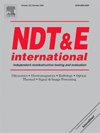Deep learning meta architecture to detect spatially coherent coarse grain regions in ultrasonic data
IF 4.1
2区 材料科学
Q1 MATERIALS SCIENCE, CHARACTERIZATION & TESTING
引用次数: 0
Abstract
This study introduces a novel methodology for detecting coarse grain volumina in ultrasonic data. The approach is based on the premise that the grain structure in metals produces ultrasonic grain noise, which can then be utilized to extract information about the grain structure. To achieve the detection of coarse grain fully embedded in finer grain material, three distinct deep learning models based on convolutional neural networks, recurrent neural networks and transformers, all derived from a shared meta architecture, were implemented and trained using ultrasonic Full-A-scan data. The proposed method was applied to a substantial dataset of synthetically manufactured coarse grain volumina, collected using a conventional single probe ultrasonic immersion system. Additionally, two baseline approaches were implemented and compared against the deep learning methods for experimental evaluation. The uncertainty of the deep learning approach was quantified using the model agnostic Monte Carlo Dropout technique, enabling the classification of predictions into high- and low-confidence categories. This research highlights the potential of deep learning in enhancing safety-critical systems and emphasizes the necessity for explainability in such domains.

基于深度学习元架构的超声数据空间相干粗粒区域检测
介绍了一种检测超声数据中粗粒体积的新方法。该方法的前提是金属的晶粒结构产生超声晶粒噪声,然后利用超声噪声提取有关晶粒结构的信息。为了实现粗颗粒完全嵌入细颗粒材料的检测,基于卷积神经网络、循环神经网络和变压器的三种不同的深度学习模型,均源自共享的元架构,并使用超声full - a扫描数据进行训练。将该方法应用于传统单探头超声浸泡系统收集的大量合成粗粒体积数据集。此外,还实施了两种基线方法,并将其与深度学习方法进行了比较,以进行实验评估。使用模型不可知的蒙特卡罗Dropout技术对深度学习方法的不确定性进行了量化,从而可以将预测分为高置信度和低置信度类别。这项研究强调了深度学习在增强安全关键系统方面的潜力,并强调了在这些领域中可解释性的必要性。
本文章由计算机程序翻译,如有差异,请以英文原文为准。
求助全文
约1分钟内获得全文
求助全文
来源期刊

Ndt & E International
工程技术-材料科学:表征与测试
CiteScore
7.20
自引率
9.50%
发文量
121
审稿时长
55 days
期刊介绍:
NDT&E international publishes peer-reviewed results of original research and development in all categories of the fields of nondestructive testing and evaluation including ultrasonics, electromagnetics, radiography, optical and thermal methods. In addition to traditional NDE topics, the emerging technology area of inspection of civil structures and materials is also emphasized. The journal publishes original papers on research and development of new inspection techniques and methods, as well as on novel and innovative applications of established methods. Papers on NDE sensors and their applications both for inspection and process control, as well as papers describing novel NDE systems for structural health monitoring and their performance in industrial settings are also considered. Other regular features include international news, new equipment and a calendar of forthcoming worldwide meetings. This journal is listed in Current Contents.
 求助内容:
求助内容: 应助结果提醒方式:
应助结果提醒方式:


